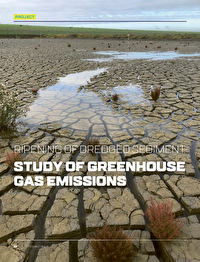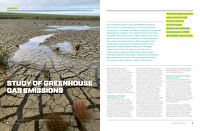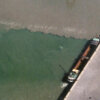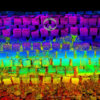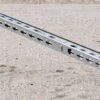Scenario 1: shallow and limited organic matter degradation (representing field data)
Based on the measured organic matter content for the different layers measured in April and June, a mean carbon loss between April and June was calculated of 2 kg C/m2. This corresponds to a mean potential GHG emission during the April to June clay ripening period of 7.7 kg CO2e m-2 of sediment (Table 1). Extrapolating to an entire single test bed (75 x 75 m or 5625 m2), we estimate the total emissions from a single clay ripening test bed was 43.1 tonnes CO2. The CO2e emissions from the entire ten ripening sites was 431.5 tonnes CO2e (Table 1). This comes down to 0.012 tonne CO2 per tonne of clay.
Scenario 2: deep, high (5%) OM degradation (desired quality)
This scenario assumed higher loss of OM (to 5%) across the whole depth transect of the sediment. As can be expected, the estimated CO2 emission in this scenario was significantly higher (27 kg CO2e m-2) than in scenario 1. In general, the CO2 emission will be proportional to the depth to which the organic matter will be degraded and the extent to which organic matter content decreases. There are currently no indications such a scenario is taking place when ripening sediment from the Ems-Dollard estuary4.
4. Evaluations are taking place to see if clay soil of a higher organic matter and salt levels can nevertheless be safely used in embankments.
Results
Given the small sample size, short sampling time and indirect measures of organic carbon, data and results must be viewed with caution, as there is a high degree of uncertainty. However, the results do suggest that carbon emissions from the clay-ripening process may be significant. Further investigation using accurate portable infrared gas analysers and intense sampling of sediment carbon pools during the entire clay ripening process is recommended in order to obtain more precise estimates of GHG emissions.
The differences in GHG emissions calculated for the two scenarios demonstrates the influence that environmental conditions, time and sediment management may have on the CO2 emissions. The depth and degree to which organic matter is degraded strongly determines the CO2 emission, and is likely strongly dependent on ripening strategy (e.g. ploughing and influencing salinity) as well as the carbon quality of the sediment organic matter. Thus, the different ripening strategies would influence the rate and quality of CO2 emissions. Furthermore, with the laboratory incubations, we demonstrated a much higher GHG emission from freshwater sediment compared to saltwater sediment. Therefore, the choice between saltwater and freshwater sediment can also strongly influence sediment-related GHG emissions, as the production of CH4 and consequently the emission of GHG is most likely much higher in freshwater sediments.
To put the numbers calculated here into context, it is useful to compare these to potential alternatives. For building dykes, an alternative source of dyke clay is the import of freshwater sediment from Belgium or other parts of the Netherlands, low in organic matter. An important component of the GHG emission related to this alternative is the emission due to fossil fuel combustion. An estimate can be made of this emission based on known numbers (www.co2emissiefactoren.nl). The GHG emissions of a truck (weighing 10–20 tonnes) is estimated to be 0.256 kg CO2/tonne kilometre (well-to-wheel). When we assume one-way transport of a loaded truck over 200 km (from Belgium to the pilot locations), this leads to an emission of: 200 km * 0.256 kg CO2/tonne kilometre = 51.2 kg CO2/tonne clay or 0.05 tonne CO2/tonne clay.
This comes down to the same order of magnitude as the GHG emissions from the clay ripening process under the worst-case Scenario 2. Actual emissions from transport will be higher, as we did not take into account other activities, and only included one-way transport. In general, these calculations should be seen as a first estimate to illustrate the methodology; for a complete comparison, emissions from several activities in both scenarios should also be taken into account.
Discussion
The urgency of all business sectors to address climate change mitigation through reduction of emissions and the sequestration of GHGs is well recognised. If we are to attain the target of the Paris Agreement, all stakeholders must act. In line with this, the Dutch government aims to reduce the Netherlands’ greenhouse gas emissions by 49% by 2030, compared to 1990 levels, and a 95% reduction by 2050. In addition, the Dutch Ministry of Infrastructure and Water Management adopted a target to achieve net-zero emissions by 2030. Companies in the maritime and dredging sector have started to adopt net-zero targets. This has already resulted in serious efforts to minimise emissions from hydraulic engineering, particularly in relation to minimising use of fossil fuels and optimising construction materials. The presented analyses in this study demonstrate a useful methodology and indicative numbers for sediment-related GHG emissions, however, many uncertainties remain that deserve further attention. Improved approaches to the sampling of GHG emissions and quantification of the carbon mass within the sediments would facilitate accurate quantification of carbon stocks and GHG emissions from the ripening process.
Direct measurements of GHG emissions are needed to confirm the findings and validate the range of applicability both in the field and in the lab (i.e. Gebert et al., 2019). The use of portable infrared gas analysers would facilitate accurate field measures of trace gas emissions (CO2, CH4, N20). Furthermore, intense sampling of sediment carbon pools during the entire clay ripening process is recommended to obtain more precise estimates of GHG emissions from the clay ripening process. This would entail repeated sampling of carbon concentrations and concentration bulk density at varying depths of the sediment beds over time.
The carbon composition and quality are also unknown. The carbon quality is a measure of the quantity of labile and recalcitrant fractions. This is important as microorganisms can readily decompose labile forms while recalcitrant carbon may indefinitely persist in sediments. Knowledge of carbon quality provides information on the time required and potential to reduce organic matter in dredged sediments. In addition, other components of the sediment, such as clay and salt, may have an impact.
Once salts are washed out of the clay and with greater oxygen penetration (via plant roots, bioturbation or after soil is mixed with sand), the degradation of the organic material will be enhanced. However, this could increase methane emissions, which would increase the global warming potential of the gases arising from this ripening process. The sediment in the two pilot projects described here is both estuarine, salt-water sediment from the same region, which could differ in several more specific parameters such as organic matter quality. For other cases, sediment properties (such as organic matter quality, salinity and clay content) might be different and it is recommended to take this into account.
If the objective of a project involving hydraulic engineering is to minimise GHG emissions or even sequester carbon, then building with nature based solutions can be applied, such as using the soft sediments for salt marsh creation where vegetation could uptake CO2 and store organic carbon in sediments. Salt marshes not only sequester carbon but also reduce wave heights. When dykes are combined with vegetated foreshores, they can be lower and still provide safety (Temmerman et al., 2013). Lower dykes require less clay and thus involve fewer emissions from clay ripening.
In this pilot study, we only focused on processes during the first stage of the ripening of the sediment and a transition from dredged sediment to clay material. Microbial degradation of organic carbon will result in loss of this organic carbon as CO2 and/or CH4. Our pilot study already suggested some parameters that affect the sediment-related GHG emissions during ripening of soft sediments: the concentration of organic carbon in the sediment, the quality of that carbon and the salinity that affects whether emissions will be limited to CO2 or not. The slow transport in and out of the sediment probably also affects degradation conditions, resulting in low availability of oxygen and slow breakdown of organic matter and slow emission of greenhouse gases.
These and other factors might differ with different dredging methods and ways of deposition during ripening. However, there are many process steps before and after the ripening period in the project where GHG emission estimates are still lacking, therefore more research on this topic is needed. The entire life cycle analysis, including the carbon losses and sediment-related GHG emissions from pre-dredging up to the moment the clay has been implemented in the dykes and the further fate of carbon, should be quantified. Finally, the use of relevant reference scenarios in the life cycle analysis is essential, e.g. of natural ecosystems or alternatives of the sediment use.
Conclusions
Our study aimed to assess GHG emissions from ripening soft sediment to dyke clay and to identify key processes involved. Given the small sample size, short sampling time and indirect measures of carbon loss, our results must be considered as a first exploration. The estimated CO2 emissions suggest that carbon emissions from the clay ripening process are potentially significant and that these emissions can be affected by the type of sediment and ripening conditions. Emissions from clay ripening ranged between 0.012 tonne CO2e/tonne of clay for our short-term field experiment up to 0.05 tonne CO2e/ tonne of clay if the desired clay quality with an organic matter content of 5% would be reached. Alternatively, if a similar amount of clay would have been collected from abroad, GHG emissions from transport alone may equal these emissions.
The results from this study offer an approach to compare GHG emissions from soft sediments to alternatives and give information on control parameters by which GHG emissions from soft sediments can be minimised. Firstly, working with saline sediment it is less likely that organic matter is converted to CO2 instead of into the more potent greenhouse gas CH4 than working with freshwater sediment. Secondly, gas exchange between sediment and atmosphere can be limited, minimising GHG emissions directly, and indirectly by maintaining anaerobic conditions. However, for freshwater sediments anaerobic conditions may stimulate emissions of the much stronger GHG CH4 . Minimising gas exchange works against the aim to reduce the organic carbon content in the sediment to 5%. Therefore, studies are performed with ripened to see whether saline clay with a higher than desired OM content (>5% OM) is affecting dyke building strength.
We recommend that sediment-related emissions are addressed in life cycle analysis (LCA) of hydraulic engineering projects, so that different options can be properly compared and well-informed decisions can be made. To achieve this, GHG emissions from and carbon sequestration in sediments need to be integrated into existing tools, such as the ones used by the Dutch government ‘DuboCalc’ or the ‘CO2 performance ladder’. Meanwhile, hydraulic engineering projects that involve soft sediments should measure and report carbon stocks and fluxes of GHGs to build up the required knowledge base.




